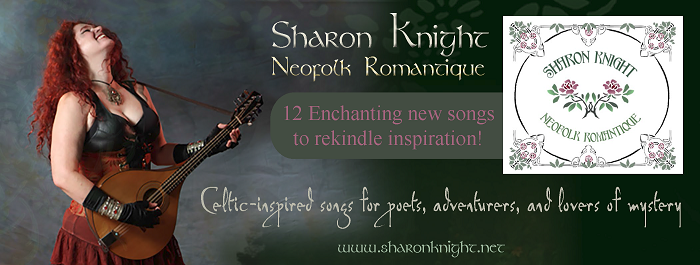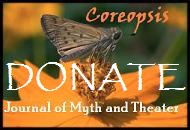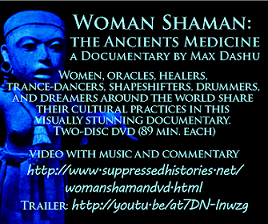
Entering the Other World of Oz: The Threshold Passage of Dorothy Gale
by Ronald L. Boyer
Sonoma State University
A hero ventures forth from the world of common
day into a region of supernatural wonder.
—Joseph Campbell
Abstract:
The 1939 family classic film, The Wizard of Oz, based on the beloved children’s tale by L. Frank Baum, represents a modern example of mythologist Joseph Campbell’s model of the hero quest myth. This two-part study begins with a theoretical overview, contextualizing The Wizard of Oz, as mythopoeic literature, and Campbell’s hero quest paradigm, informed by Carl G. Jung’s theories and methods as well as other key sources. The second part of the study applies Campbell’s model to the text of Baum’s Oz narrative in both its cinematic and literary forms, examining Baum’s tale for archetypal features described in Campbell’s model of the initial stage of the “leitmotif of the monomyth.” This comparative analysis emphasizes the myth-motif of the threshold passage accompanied by sequentially interconnected, recurring myth-motifs identified by Campbell and associated with the initial stage of Dorothy Gale’s transformational journey, i.e., separation from ordinary reality. This narrative interpretation demonstrates key symbolic features of mythico-ritual (initiatory) structure in the initial stage of Baum’s modern fairy tale. Screenshots from the movie visually illustrate that Dorothy’s journey in the other world of Oz closely follows the archetypal, symbolic structure of Campbell’s classic quest myth of the hero.
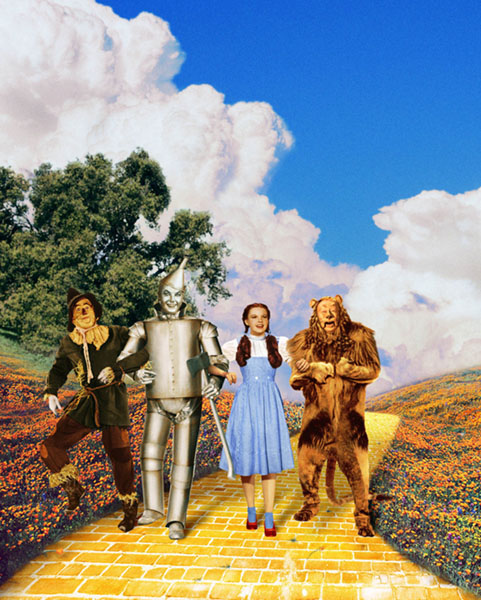
Dorothy and companions travel down the Yellow Brick Road. Photo courtesy of Warner Bros. Entertainment, Inc.
Children’s author L. Frank Baum (1900) penned his popular, classic masterpiece, The Wonderful Wizard of Oz, as the Victorian Era drew to a close. In the ensuing years since publication of his children’s tale, Baum’s story has inspired myriad artistic interpretations, including the famous 1939 movie adaptation, The Wizard of Oz. The ever-popular film, starring Judy Garland as “Dorothy Gale,” resulted in the Oz adventure’s role as a holiday family film classic, viewed by millions of Americans annually around Thanksgiving. This firmly established Baum’s story in American popular culture as one of the great modern American “myths.” The Wonderful Wizard of Oz spawned its own ongoing mini-industry, beginning with fourteen Oz books by Baum himself, as well as inspiring a dynamic narrative legacy of Oz-related stories written by various authors, with frequent adaptations for theater and film (Morena, 1998, pp. 7-8). A genuine pop culture phenomenon, the Oz narratives feature a number of stage productions, including the Tony-award-winning Broadway musical, The Wiz (1975),also adapted for film, and more recently, the hit Broadway musical, Wicked: The Untold Story of the Witches of Oz (2003), based on the 1995 Oz-inspired novel by Gregory Maguire. Two recent movies inspired by Dorothy’s adventures in Oz include the Disney prequel, Oz the Great and Powerful (2013), and the animated musical, Legends of Oz: Dorothy’s Return (2013) based on a story by Baum’s great-grandson, Roger Baum.
In his Introduction to The Wonderful Wizard of Oz, Baum (1900) defines his children’s story as a “modernized fairytale” or “wonder tale” (p. 1),a modern variation of the traditional folk fairytale. As a modern literary fairytale, Baum’s story may be characterized as mythopoeic (or mythopoetic) literature, a literary genre that “creates a new and transformative mythology, or incorporates and transforms existing mythological material” (Mythopoeic literature, n.d.). Mythopoeic literature, and its cinematic narrative equivalents, is a modern and contemporary storytelling genre in which key elements of “myth-making” (the original Greek meaning of mythopoeic) are used in the creation of myth-like, fictional narratives. Archetypal literary theorist, Northrop Frye (1963), observes that “myth is a structural element in literature because literature as a whole is ‘displaced mythology’” (p. 1; pp. 21-38), based on “archetypes of literature” (p. 7-20) with the quest myth at its center. Asserting that all literature is informed by “preliterary categories such as ritual, myth and folk tale” (pp. 12), Frye identifies mythopoeic literature with the central English poetic tradition of Blake, Shelley, and Yeats, among others (pp. 1-2).
Mythopoeic literature remainsclosely associated with the author J. R. R. Tolkien and his fellow Oxford “Inklings,” a group of prominent 20th century authors that includes C. S. Lewis and Charles Williams. In 1931, Tolkien (2001) popularized the term “mythopoeia” (pp. 83-91) in his famous poem of that name, written in defense of myths as legitimate sources of truth. In 1947, Tolkien (2001) similarly defended fairytales as a distinct and authentic literary form in his influential essay, “On Fairy-Stories” (pp. 1-82), in which Tolkien explains his views on mythopoeic narrative. The mythopoeic genre is closely related to fantasy or speculative fiction, a genre in which Tolkien and Lewis are acknowledged pioneers. The genre is recently exemplified in the popular TV series, The Game of Thrones, adapted from the novels by George R. R. Martin.
Baum’s modern fairytale occupies a unique, early historical position within the evolving canon of this myth-based narrative genre, given the story’s extraordinary and enduring popularity and iconic status in contemporary American culture. Baum’s story, as many readers will recall, is a tale about “Dorothy Gale,” an orphan girl from Kansas whose desire to protect her pet dog Toto sets in motion a chain of events leading Dorothy and Toto on extraordinary adventures in another world called Oz.
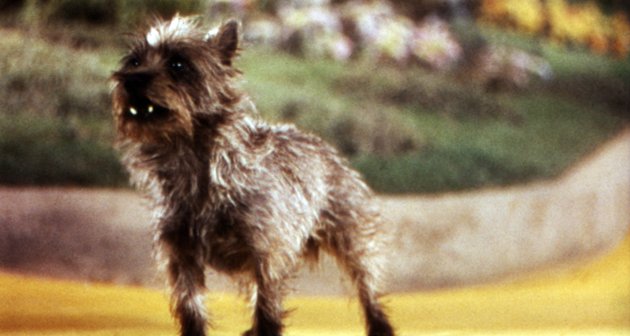
Toto is Dorothy’s pet, best friend, and alter-ego in the tale. Photo courtesy of Warner Bros. Entertainment, Inc.
Soon after landing in Oz, Dorothy discovers that her house fell on the Wicked Witch of the East, whose ruby slippers magically appear on Dorothy’s feet. Dorothy and Toto embark on a quest to return home to Kansas, guided by Glinda the Good Witch and aided by three lovable companions Dorothy meets along the way—Scarecrow, Tin Man, and the Cowardly Lion.
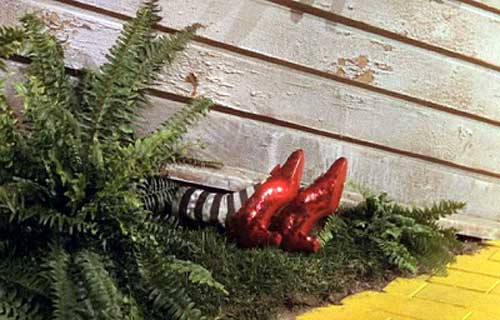
Dorothy’s farm house lands in the other world on the Wicked Witch of the East, establishing Dorothy as the national hero of Munchkin Land. Photo courtesy of Warner Bros. Entertainment, Inc.
From the very start of her journey, Dorothy is relentlessly pursued by her powerful and shadowy nemesis, the Wicked Witch of the West. Completing an ultimate trial demanded by the reputedly all-powerful Wizard of Oz, Dorothy defeats the Witch and returns to the Emerald City to see the Wizard. There Dorothy learns that the power to return home to Kansas has been inside her all along. She taps her ruby slippers together and awakens in her farmhouse bed, surrounded by her loved ones.
Jung’s Archetypes as Primordial Images
Around the time Baum first published The Wonderful Wizard of Oz, a small cadre of innovative psychological theorists on the European mainland, using Freud’s symbolic analysis of dreams as a point of departure, were breaking important theoretical ground with interpretive discoveries shedding light on the symbolic language of myths and fairytales like Baum’s, making them accessible to systematic psychological interpretation. Chief among these analyst-scholars—at least for present purposes—was Carl Gustav Jung (1916/2001) who, in a letter to Freud written in 1909, declared that “mythology has me in its grip” (as cited by W. McGuire, p. xxvii). A few years later, Jung broke with Freud following publication of Jung’s seminal work, Psychology of the Unconscious (1916/2001)—later revised as Symbols of Transformation (1916/1990)—in which Jung proposes an alternative theory for the psychological interpretation of symbols and dramatically broadens the application of depth psychology’s interpretive potential beyond Freud’s theories.
In his important essay on The Structure of the Psyche, Jung (1927/1974) distinguishes his concept of the unconscious from Freud’s. Jung posits the psychological metaphor of a “collective unconscious” that is the “ancestral heritage of possibilities of representation” and that, in contrast to Freud’s model, “is not individual but common to all men” (p. 38). Jung further characterizes this collective unconscious as a “timeless and universal psyche” and describes the psyche’s primitive capacity for representing recurring, “affect-laden” situations as fantasies described in a “picture language” consisting of “myth-motifs.” According to Jung:
The whole of mythology could be taken as a sort of projection of the collective unconscious. The collective unconscious—so far as we can say anything about it at all—appears to consist of mythological motifs or primordial images, for which reason the myths of all nations are its real exponents. (p. 39)
Jung (1959/1980) famously called these primordial images “archetypes of the collective unconscious,”recurring symbolic and metaphorical motifs found throughout the world’s fairytales and myths since ancient times. The basis for his theories of archetypes and the collective unconscious, as well as his interpretive method (called “amplification”), derives from Jung’s observations that these primordial images spontaneously reappeared in the fantasies, dreams, and therapeutic art of his modern psychotic patients as well as in Jung’s own dreams, visions, and transformative life-experiences (Jung, 1961/1989). Amplification, a term Jung presumably borrowed from scholar J. J. Bachofen (1992, p. li, para. 4), consists simply of observing analogous patterns of myth-motifs wherever they appear, for example, as recurrent images found in the world’s fairytales and myths. Jung’s term “archetype” refers to the widely-recurring nature of these symbolic forms, unlimited by time and space. Jung (1937/1958) further defines archetypes as “forms or images of a collective nature which occur practically all over the earth as constituents of myths and at the same time as autochthonous [indigenous], individual products of unconscious origin” (para. 88, p. 50).
Significantly, such definitions of the archetypes suggest an integral relationship between the subjective psyche of the individual and psychic contents or images expressed in the objective forms of art, including mythic and fairytale narratives. In the same essay in which he defines archetypes as primordial images, Jung (1927/1974) illustrates his theory by drawing an analogy between modern, internal psychological states and a primitive view of the external world, based on observations of natural cycles like the sun’s daily descent into darkness and return at daybreak. Jung describes a standard, “conglomerate myth” in which:
Every morning a divine hero is born from the sea and mounts the chariot of the sun. In the West a Great Mother awaits him, and he is devoured by her in the evening. In the belly of a dragon he traverses the depths of the midnight seas. After a frightful combat with the serpent of night he is born again in the morning. (pp. 39-40)
Jung’s (1916/1990) interpretation of the sun-hero’s journey as a reflection of unconscious psychological processes is a primary subject of Symbols of Transformation. In his chapter on “The Origin of the Hero” (pp. 171-206), Jung interprets this archetypal hero as a symbolic image of the libido (life-force), personified as a more-than-human individual who descends into the depths of the unconscious, an experiential process analogous to the cyclical descent of the sun at nightfall. “Here,” writes Jung, “the symbolism leaves the objective, material realm of astral and meteorological images and takes on human form” (p. 171). Expanding on his observations of the analogies between the cyclical nature of both inner and outer events, Jung further defines the essence of the hero as a figure “who passes from joy to sorrow, from sorrow to joy; and like the sun, now stands high at the zenith and now is plunged into the darkest night, only to rise again in new splendor” (p. 171).
Jung (1916/1990) further develops his interpretation of the sun-hero in the context of rebirth symbolism (pp. 207-271), solar heroes being figures who take “night sea journeys” (p. 210) that he equates symbolically with mythical “underworld” journeys—Jung uses the Greek terms nekyia (p. 431) and katabasis (p. 365) interchangeably—into the depths of the unconscious. Jung interprets this archetypal journey of descent as a symbolic return to the mother’s womb, there to find the life-force that renews the hero and returns the hero to life, reborn (pp. 210-212). “The night sea journey is a kind of descensus ad inferos, a descent into Hades,” Jung writes (1954/1992),“and a journey to the land of ghosts somewhere beyond this world, beyond consciousness, hence an immersion in the unconscious” (pp. 83-84).
In “Concerning Rebirth,” Jung (1959/1980) develops his theories regarding the symbolism of the rebirth image, suggesting that the death-rebirth structural motif is the “archetype of transformation” (p. 81). Jung equates rebirth (or renovatio) with a psychic transformation he characterizes as an “individuation process,” Jung’s model for human development. Jung compares this transformative process to primitive rites of initiation, emphasizing that individuation is accomplished through a process resembling initiatory ordeals. In Jung’s view, individuation—becoming who we truly and uniquely are—is the “ultimate goal of human life” (Eliade, 1958, p. 135).
Campbell’s Archetypal Hero Quest Model
Four decades after Jung declared himself “in the grip of myth,” the mythologist and Jungian scholar, Joseph Campbell, transformed Jung’s conglomerate sun-hero myth, structurally intact, into his own composite model called the hero quest myth. Inspired by Jung, Campbell (1973) popularized Jung’s theory of archetypes in his own now classic work, The Hero with a Thousand Faces. In his Preface to that work, Campbell acknowledges the theoretical and interpretive debt he owes to depth psychology, in particular to Jung. Campbell invites his readers, in a spirit Tolkien would have admired, to embrace “truth in symbolic clothing,” to learn to read with fresh understanding the “language” of myth constructed in a “grammar of symbols” (p. vii). Campbell suggests that a key to comprehending this ubiquitous, image-based language is found in the “modern tool” of psychoanalysis.
In this influential study, Campbell identifies, describes, and creatively interprets the recurring symbolic forms, figures, events, situations, and themes typical of the hero quest myths of the world. Campbell (1973) evokes Jung when he writes in his Introduction that the “archetypes . . . have inspired, throughout the annals of human culture, the basic images of ritual, mythology, and vision” (p. 18). He also retains Jung’s psyche-based approach to the analysis of archetypal images in fairytales and myths, interpreted by Campbell as symbolic descriptions of the “adventure of the discovery of the self” and projected expressions of the “mythological realm that we carry within” (p. 8).
In his description of the hero quest, Campbell builds directly on Jung’s interpretive writings on the sun-hero. In an apparently direct reference to Jung’s conglomerate myth of the sun-hero, Campbell (1973) reaffirms Jung’s analogy of the descending cycles of the sun and of the human psyche, asserting that, “in order to advance, the shining sphere must submit to descend and disappear, at last, into the night-womb of the grave” (p. 12). Like Jung, Campbell acknowledges an integral, cyclical relationship between the opposites of birth and death, expressed symbolically in the mirror of nature. Campbell suggests that the symbolic womb is also a tomb, and the tomb is also a womb. We come “full circle,” says Campbell, “from the tomb of the womb to the womb of the tomb” (p. 12). This womb-tomb metaphor unites the opposites of life and death in a single theme. In this paradoxical image of the unity of the opposites of birth and death, of womb and grave, Campbell offers a powerful metaphor for the cyclical birth-death-rebirth imagery associated with mythic gods and heroes.
Every hero, says Jung (1916/1990), yearns for the “mystery of rebirth” (p. 272). The hero symbolically returns to the womb of the Mother, the collective unconscious, Jung would say, not out of a Freudian impulse to incest, but in order to symbolically die to the old self and be reborn as a “twice-born” hero from the womb that initially gave birth. Campbell maintains key features of Jung’s interpretation while freeing his own interpretation from the theoretical fetters of the analyst created by Jung’s view of the sun-hero’s cycle as a metaphor for the journey of the libido (life-energy) into the unconscious. For example, Campbell confirms Jung’s view of the death-rebirth journey as the basic structural metaphor of sun-hero myths, a process pictured archetypally in the directional and topographical symbolism of the hero’s inward journey of descent-and-ascent (descent-and-return).
Like Jung, Campbell (1973) recognizes the various symbolic representations of the hero’s journey of descent, the underworld wanderings of heroes like Theseus and the Goddess Inanna. Jung’s downward trajectory of the hero cycle, described in the primordial imagery of night sea journeys and nekyia journeys into the underworld, survives in Campbell’s observation that the hero’s quest is always an inward journey “into [the] depths” (p. 29). The complete arc of symbolic death-rebirth, he continues, is the “single mythological theme” of “downgoing and upcoming (kathodos and anodos), which together constitute the totality of the revelation that is life” (p. 28). Campbell essentially retains Jung’s view of rebirth as renovatio, a psychological process of transformation within the human life-cycle symbolically expressed in the cyclical imagery of death and rebirth (descent and return) as the means through which the individual is regenerated and renewed. “Only birth can conquer death,” Campbell (1973) writes, “the birth not of the old thing again, but of something new. Within the soul . . . there must be . . . a continuing ‘recurrence of birth’ (paligenesis)” (p. 16). In his famous poem, “Holy Longing,” Goethe (1814/1980) expresses a similar idea: “And so long as you haven’t experienced this: to die and so to grow, you are only a troubled guest on the dark earth” (p. 70).
Campbell begins to distinguish his view of the hero journey from Jung in his greater emphasis on the structural analogies of myth and ritual. While Jung observes correspondences between the individuation process, his developmental model, and initiatory symbols, Campbell focuses on the structural similarities of myth and ritual, suggesting that processes of metaphorical death-rebirth represent universal crises and transitions in the human life-cycle formerly addressed in initiatory “rites of passage,” a term borrowed from the title of folklorist and ethnographer Arnold van Gennep’s (1975) important early study by that name. While the analyst Jung emphasizes the analogies between the sun-hero’s journey and transformative processes of the libido, Campbell (1973) emphasizes the importance of archetypes as pedagogical maps based on universal cycles of human development, developmental stages symbolically described in the forms of “ageless initiatory symbolism” (p. 12). Campbell relates Jung’s archetypes specifically to human life-cycle development, addressed in earlier times through initiatory “rites of passage.” Traditional rites of passage, he observes, are used to “teach the individual to die to the past and be reborn to the future” (p. 15).
Campbell’s shift of emphasis from mythic narratives to their structural affinities with initiatory rites was the outcome of yet one more element of Jung’s interpretive approach retained by Campbell: Jung’s method of “amplification.” In addition to preserving the essence of Jung’s theoretical insights and interpretations of the sun-hero cycle as a metaphor of psychological transformation, Campbell relies on Jung’s interpretive method of archetypal analogy, applying it to the systematic and comprehensive study of hero quest myths from around the world. He views Jung’s sun-hero journey through the lens of hundreds of hero myths, and on that basis, creates a composite, standard model that defines a basic structure and key symbolic motifs of hero journeys described by various cultures. “Essentially,” concludes Campbell (1991), “it might even be said there is but one archetypal mythic hero whose life has been replicated in many lands by many, many people” (p. 166). Borrowing terminology from author James Joyce, Campbell (1973) calls this tripartite journey of the hero the “leitmotif of the monomyth,” structurally defining the “standard path of the mythological adventure of the hero” (p. 30).
Interpretation of the hero quest-journey within the sequential, three-stage structural framework of the monomyth represents Campbell’s major innovation on Jung’s approach. While Jung’s sun-hero analogy implicitly describes the cycle of birth-death-rebirth in the imagery of descent and return, Campbell interprets this journey of “downgoing and upcoming” within a clearly defined symbolic structure, modeled on both hero myths and analogous archetypal structures found in initiation rites. The symbolic structure of this presumably universal quest myth, says Campbell (1973), is modeled on the ancient initiatory formula of “separation-initiation-return” (p. 30), a structural paradigm resembling the three-stage model of initiation described by Campbell’s colleague and contemporary, the historian of religions, Mircea Eliade, as well as the three-stage model of rites of passage defined earlier by van Gennep (1975), further developed by anthropologist Victor Turner (1991). Campbell considers this tripartite initiatory model the nuclear unit of narrative structure. The basic structure of mythic narrative, says Campbell, follows this basic three-stage pattern:
A hero ventures forth from the world of common day into a region of supernatural wonder: fabulous forces are there encountered and a decisive victory is won: the hero comes back from this mysterious adventure with the power to bestow boons on his fellow man. (p. 30)
The archetypal convention of a three-stage narrative structure has been observed as the general shape of storytelling since Aristotle’s (trans. 1981) Poetics, authored in the 4th century B.C. A basic convention of story arts, Aristotle’s classic narrative paradigm—consisting of “beginning-middle-end”—continues to frame story narratives down to the present day. Campbell’s model of mythic structure, like the structural frameworks van Gennep and Eliade apply to initiation rites, recalls the ritual and initiatory origins of ancient Greek drama upon which Aristotle’s model of narrative is based. The symbolic structures of initiatory and healing rites in ancient Greek mystery religions, e.g., the rites performed at Eleusis and Epidaurus, also exemplify this archetypal initiatory sequence of symbolic separation-death-rebirth.
Eliade (1974; 1958) anchors the remote origins of this symbolic structure in the initiatory experiences attributed to shamans. He describes the experiential phenomena associated throughout the world with shamanic initiations, the presumed primeval source from which initiatory rituals are apparently derived. As the world’s likely first artists, storytellers, myth-makers, and psychopomps, primordial shamans—or their proto-shaman equivalents during the approximately quarter million year evolution of homo sapiens sapiens (Rock and Krippner, 2011, p. 31 & p.65)—first represented the transformative developmental processes of early humans in the symbolic forms of their local, indigenous community’s sacred mythical narratives,enacted in ceremonial rites. In his pioneering work, Shamanism: Archaic Techniques of Ecstasy, Eliade (1974) observes the archetypal structure of shamanic narratives, beginning with symbolic descriptions of the initiatory experiences reported by shamans. On this basis Eliade, a colleague of Campbell also influenced by van Gennep (1974, p. 64), similarly proposes a tripartite initiatory pattern of “suffering-death-rebirth” in which he identifies the “symbolism of death and mystical resurrection” (p. 55) as integral symbolic features of shamanic initiations and derivative rites throughout the world. He discusses the determinants of the shaman’s future vocation as involving the traditional schema of an initiation ceremony: suffering, death and resurrection. Viewed from this angle, any ‘sickness-vocation’ fills the role of an initiation; for the sufferings that it brings on correspond to initiatory tortures, the psychic isolation of ‘the elected’ is the counterpart to the isolations and ritual solitude of initiation ceremonies, and the imminence of death . . . recalls the symbolic death represented in almost all initiation ceremonies. (p. 33)
Campbell’s model implicitly identifies the hero of myth with the shaman and initiate as personifications of the transformative principle of death and rebirth, the essential symbolic structure enacted in initiatory rituals, including rites of passage. Campbell introduces his model with a summary of van Gennep’s model of initiation, published less than a decade after The Wonderful Wizard of Oz. In The Rites of Passage, originally published in 1909, van Gennep (1975) distinguishes three major phases of ceremonial activities he defines as “severance-transition-incorporation” (p. 21), also described as preliminal, liminal (threshold), and post-liminal rites. Van Gennep views the symbolic purposes of such rites as methods for the renewal of society, expressed in the imagery of death and rebirth.
In his Introduction to The Hero with a Thousand Faces, Campbell (1973) summarizes van Gennep’s model as a symbolic ritual structure that begins with “exercises of severance, whereby the mind is radically cutaway from the attitudes, attachments, and life patterns of the stage being left behind” (p. 10). After an extended interval—van Gennep’s second stage of “transition”—the initiate returns to the normal world, in which the “initiate will be as good as reborn” (p. 10). The first task of the hero, Campbell suggests, is like that of the initiate: To separate or withdraw “from the external to the internal world” (p. 17). The second task of the hero, Campbell writes, also imitates the initiate’s transformational arc: To “return then to us, transfigured, and teach the lesson he has learned of life renewed.” Such heroes, says Campbell (p. 20), have died as modern individuals, but are reborn as “eternal” or “universal” individuals. Campbell thus equates the heroes of mythology to the archetypal initiates in rites of passage.
The following analysis addresses the first stage of the monomyth narrative, the hero-initiate Dorothy Gale’s withdrawal “from the external to the internal world,” pictured as a call to adventure and threshold passage that radically separates Dorothy from home, family, and her familiar life in Kansas. In this symbolic “exercise of severance,” Dorothy is radically separated from the preadolescent life-stage she must leave behind, as she ventures forth into an inner realm, the other world of “supernatural” wonder in which powerful, more-than-human allies and enemies are encountered. This preparatory stage of Dorothy’s journey precedes the transformative, death-rebirth journey of the initiate-hero, pictured in myths and rituals the world over as the archetypal descent, road of trials, and return journey that complete the familiar story arc of the hero’s quest.
Monomyth (Stage 1): The Separation from Ordinary Reality
The initial stage of Campbell’s monomyth introduces several archetypal figures, situations, themes, and events. Before proceeding, it may be helpful to note that not all mythic narratives include all of these motifs, nor do they necessarily always appear in the exact sequence defined by Campbell. Campbell’s hero quest is a model, a “composite” or standard narrative trajectory derived from his study of literally hundreds of myths the world over (Houston, 2012, p. 2). As such, his theory of a single great universal theme or leitmotif, echoed in myriad local, time- and place-specific variations, allows for practically endless creative variety. In this sense, Dorothy’s adventure in Oz is at once a unique and relatively modern artistic expression and a faithful reincarnation of the standard monomyth, which might rather be called a “protomyth” to shift emphasis from its somewhat debatable universality to its indisputably primordial origins.
The Hero’s “Ordinary” Life
Like most heroes, the point of departure for Dorothy’s adventures in Oz begins with her ordinary or common-day life, her “myth of origins.” Hidden within this apparently ordinary life, a numinous mystery often surrounds the mythic hero’s conception, birth, and childhood. Dorothy, like so many heroes of mythologies and fairytales—and derivative storytelling forms, including literature and film—is an archetypal or “mythic” orphan. This vital story element is suggested in the movie when Dorothy addresses her presumed parents as “Auntie” Em and “Uncle” Henry.
In the original story by Baum, Dorothy’s orphan status is explicitly described in the opening pages of the tale. Baum (2001) first establishes the ordinary world of Dorothy Gale as a desolate landscape of “gray prairie” where even the “grass was not green” and the “sun had burned the tops of the long blades until they were the same gray color to be seen everywhere” (pp. 1-2). The desolate outer landscape serves as a metaphor of the people who live there, specifically Dorothy’s foster mother, “Aunt Em:”
The sun and wind had changed [Aunt Em], too. They had taken the sparkle from her eyes and left them a sober gray; they had taken the red from her cheeks and lips, and they were gray also. She was thin and gaunt, and never smiled now. When Dorothy, who was an orphan [italics mine], first came to her, Aunt Em had been so startled by the child’s laughter that she would scream and press her hand upon her heart whenever Dorothy’s merry voice reached her ears; and she still looked at the little girl with wonder that she could find anything to laugh at. (p. 2)
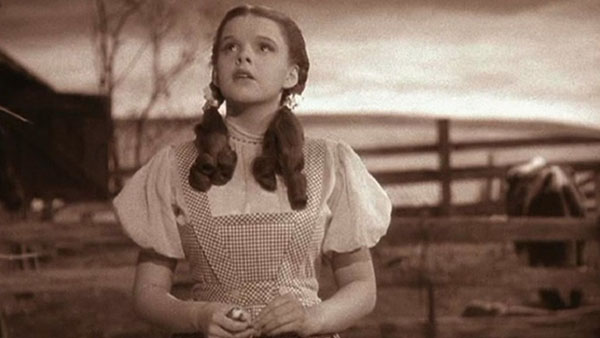
At home on the farm in Kansas, the orphan Dorothy Gale senses the gathering storm, yearning for “somewhere, over the rainbow.” Photo courtesy of Warner Bros. Entertainment, Inc.
This archetypal origin myth places Dorothy in a lineage of mythic heroes dating back to the ancient myths of culture founders like Moses and Sargon the Great, and from there back to the primordial creation myths of the world. Erich Neumann (1974, p. 20) credits the German scholar of Near Eastern religions, Alfred Jeremias, for demonstrating that “the essence of the mythological canon of the hero-redeemer is that he is fatherless or motherless” (p. 133). Neumann further suggests a symbolic analogy between the mythic orphan and the hero born of a virgin. This common mythological and fairytale motif of the parentless hero is amplified and interpreted psychoanalytically by Otto Rank (1964) in his classic study The Myth of the Birth of the Hero, in which he discusses examples of mythic “foundlings” like King Arthur and Tristan. The orphan motif is further interpreted by Kerenyi and Jung (1949/1973). “Ancient mythologems of child gods are surrounded by, and evoke, an aura of fairytale” (p. 27), writes Kerenyi, who observes that the “child god is usually an abandoned foundling” (pp. 28-29), a figure he identifies with the mythological and fairytale orphans of European and Asian folklore. Jung (1916/1990, p. 26) also identifies this motif with the hero, as the one who is born of dual mothers, suggesting the symbolic relationship of the orphan-hero to rebirth. “Anyone who is reborn in this way,” writes Jung, “becomes a hero, a semi-divine being” (p. 321).
In my opinion, insufficient attention has been given to this convention of the mythic orphan archetype as an overarching symbolic clue to a central meaning of the hero journey. Overlooked by Campbell as a key feature of the monomyth, although discussed indirectly in later chapters of The Hero with a Thousand Faces when he explores the subject of cosmogonies, this is one of most common of all archetypal images associated with hero quests. Furthermore, this motif’s importance as a vital symbolic clue to the nature of the hero quest remains insufficiently understood. The appearance of this frequently recurring myth-motif is at once a way of defining the hero as hero—Jung’s “semi-divine being”—and a symbolic hint to the nature of the narrative itself as a form of “identity quest,” an interpretation initially discussed in a graduate paper (Boyer, 2011, pp. 4-5) and developed further in a paper presented at the Symposium for the Study of Myth (Boyer, 2012). In the past few decades, the importance of this image of the mythic orphan has drawn increasing attention from psychological scholars, including Pearson (1998), Hudlin (1989), and Morena (1998). Both Hudlin and Morena, a Jungian analyst and Baum’s great-granddaughter, identify Dorothy Gale as an archetypal orphan-hero. “Dorothy represents,” says Morena (1998), “the archetypal orphan embarking on a heroic journey” (p. 11). And like similar orphan-heroes of the world’s fairytales, mythologies, literature, and film, Dorothy’s quest begins with the crossing of a symbolic “portal” or “threshold” into an “other world,” terms frequently employed by van Gennep (1975, pp. 20-158).
The Call to Adventure and Refusal of the Call
According to Campbell (1973), the hero’s journey begins with a “call to adventure” (pp. 49-58). Sometimes, the hero follows the call willingly and deliberately. More typically, the call occurs as the result of some unforeseen and disastrous event. Dorothy’s call comes as she rescues her dog Toto from the cruel Miss Gulch. Tempted to leave home in order to protect her dog, Dorothy attempts to run away, initiating her attempted separation. But along the way, an archetypal Wise Old Man appears, a personification of the Self (the ruling principle of the total personality, both conscious and unconscious) that Jung (1916/1990) identifies among the “dominant archetypes” (p. 391). In the Oz narrative, this archetypal figure appears in the form of a kindly, well-intentioned charlatan, “Professor Marvel” (Frank Morgan), who reads Dorothy’s future in a crystal ball and convinces her to ignore the call. Dorothy returns home, the call temporarily unheeded, her initial attempt to separate from ordinary reality failed.
As Campbell (1973) suggests, not all heroes choose to accept the call. Some, like Luke Skywalker in the movie Star Wars, resist the call to heroism and take up the path with great reluctance. Campbell refers to this situation as the “involuntary call” (pp. 49-68) and, as Campbell and others warn, it can be dangerous to resist. “Refusal of the summons,” says Campbell, “converts the adventure into its negative.” Typically, illness, tragedy or even death awaits heroes who refuse the voice that calls them to destiny, a fate shared with shamans who resist the call to election (Eliade, 1974, pp. 33). The character Luke Skywalker, for example, returns home only to discover that his adoptive parents (like Dorothy, his “Uncle” and “Aunt”) have been murdered in his absence, removing all obstacles to Luke leaving home to follow his destiny, the path of the Jedi, under the tutelage of Jedi-master, Obi-won Kenobi.
The biblical hero Jonah and the Celtic hero Tristan are also examples of this convention of the reluctant hero. Tristan is abducted by pirates; Jonah is swallowed by a whale. Both are liberated from captivity when supernatural tempests threaten to doom the ships that carry them. Homer’s heroes, Achilles and Odysseus, were similarly reluctant to heed the call to arms at Troy. Achilles hid in a temple disguised as a female hierophant; Odysseus disguised himself as a farmer. On the journey home from Troy, fate calls Odysseus, in the form of a tempest caused by the god Poseidon that sends the hero away on new adventures in strange, faraway lands. The Hebrew God, Yahweh, spoke to Job out of a whirlwind. As Campbell (1973, p. 59) points out, the consequences of the so-called Chosen People resisting Yahweh’s call is terrible: “Because I have called, and ye refused . . . I will mock when your fear cometh . . . as desolation, and your destruction cometh as a whirlwind.”
Dorothy Gale is a reluctant or “involuntary” hero of this type. After her fateful meeting with Professor Marvel, she intends to return to her ordinary life. But her destiny calls again, this time in the form of a tornado, reminiscent of the tempests and whirlwinds that called Job, Odysseus, and numerous heroes in Shakespeare’s plays to their adventures. In Dorothy’s case this force of nature initiates her adventure by blowing a windowpane into her head, knocking her unconscious, nearly killing her. This dramatic outer event sends the hero deep within, where a series of nightmarish visions accompany Dorothy as she enters a “liminal” or threshold space “in between” the worlds, a ritual motif suggested by van Gennep (1975) and further developed by Turner (1969), Mann (2003), and Rodriguez (2003). Rodriguez cites The Wizard of Oz as an example of the liminal, observing that “Dorothy leaves the mundane world by way of tornado” (para. 16). In short, to borrow one of Campbell’s favorite metaphors, Dorothy is carried forth to adventure “in the belly” of the tornado, just like Jonah, Pinocchio, and countless heroes are carried forth in the belly of a dragon or a whale, a major archetypal motif of the hero quest discussed at length by Campbell (1973, pp. 90-97).
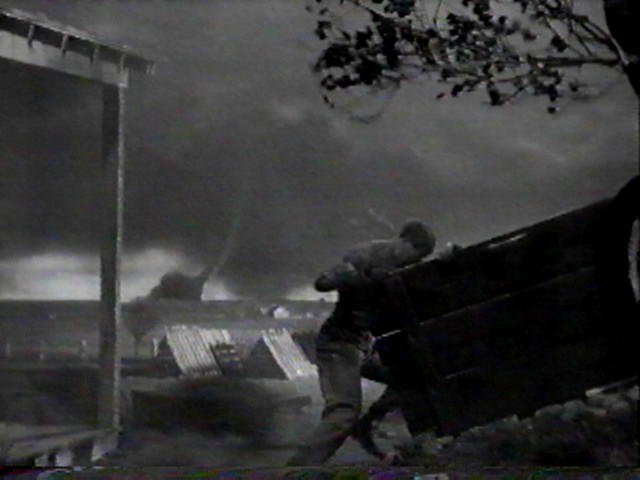
Dorothy’s call to adventure approaches her home in the shape of a tornado. Photo courtesy of Warner Bros. Entertainment, Inc.
Again, the motif of being swallowed by a monster is interpreted by Jung (1916/1990) as a symbol of death and rebirth, a myth-motif credited by both Jung (p. 210) and Campbell (p. 209) to the earlier writings of Leo Frobenius (Das zeitalter des sonnengottes, 1904, p. 30). “The idea that the passage of the magical threshold is a transit into a sphere of rebirth,” writes Campbell, “is symbolized in the worldwide womb image of the belly of the whale” (p. 90).
Crossing the Threshold to the Other World
This archetypal transition to the other world typically requires, as both van Gennep (1975) and Campbell (1973) suggest, a “threshold passage,” a crossing through a symbolic portal or “gateway” that signifies entry to the other world. In primitive rites of passage, initiates are symbolically separated from their parents and often undergo ordeals requiring some form of sacrificial wounding or sickness. Heroes share this motif of a difficult symbolic passage with initiates. “Heroes,” writes Morena (1998), “often are catapulted into their adventures by unforeseen calamities or natural catastrophes” (p. 11). Dorothy—head-wounded, knocked unconscious—approaches the liminal reality that Campbell calls the “crossing of the first threshold” (pp.77-89).
The manner of Dorothy’s passage is consistent with her earlier refusal of the call. She doesn’t choose a quest to Oz as much as she can be said to be chosen by it, being metaphorically “abducted” by a tornado, a monstrous and terrible force of nature that swallows and transports her. Dorothy’s hero journey begins not with a conscious choice, as a deliberate act of will, but as the result of a terrible and fateful accident that sets the hero, in a deathlike coma, on an inward dreamlike adventure to a realm of wonder. This aspect of Dorothy’s journey invites further comparison to the initiatory, experiential phenomena reported by shamans. As Eliade (1974, p. 33) observes, the form of the shaman’s call often involves the onset of a deathly sickness, wound or injury. Furthermore, this threshold passage occurs without Dorothy’s conscious and deliberate participation, i.e., Campbell’s “involuntary call.” “This is a type of adventure,” Campbell might say of Dorothy’s adventure in Oz, “in which the hero has no idea what he is doing but suddenly finds himself in a transformed reality” (p. 58).
The philosopher Jean Houston, a colleague of Campbell, confirms the initiatory nature of the Oz narrative, suggesting its correspondence to the structure of Campbell’s monomyth. In an unpublished script developed for a seminar many years ago (Houston, 2012, pp. 195), Houston notes (personal communication, Oct. 14, 2010):
What you see here is not only myth but also a powerful ritual initiating drama with a prologue in Kansas, the main story in Oz and epilogue back home in Kansas. Explicitly, it is about Dorothy’s initiatory rite of passage from Kansas or home, through Oz . . . the deep archetypal world . . . and back to Kansas. (para. 6)
Like so many shamans, initiates, and heroes before her, Dorothy’s initiatory quest truly begins with complete separation from her ordinary life. In Dorothy’s case, a transitional passage occurs that transports her from her dull life on the plains of Kansas to a magical and perilous realm of Oz. The highly visual nature of cinematic narrative offers a distinct advantage in depicting this threshold passage over the less obvious transition described in Baum’s book. In the popular 1939 film version of the tale, Dorothy’s venturing forth “from the world of common day into a region of supernatural wonder” (Campbell, 1973, p. 30) is made dramatically clear. A powerful visual metaphor marks the boundary between worlds: the monochromatic sepia-toned “gray” of Dorothy’s ordinary life in Kansas contrasts starkly with the wondrous Technicolor landscape of the adventure in Oz, the otherworldly “region of supernatural wonder” in which she finds herself. Even children in the viewing audience intuitively recognize that Dorothy and Toto aren’t in Kansas anymore.
Houston observes that the threshold passage to Oz is amplified by a series of visual motifs involving threshold or portal symbols. “In watching again The Wizard of Oz,” writes Houston (2010), “what I found fascinating was the montage of doors and windows that attended the coming of the tornado” (para. 12). Houston identifies no less than seven such images evident in the narrative sequence of Dorothy’s threshold passage, culminating in a “final gateway” as we follow her descent into the other world through the spiraling tornado seen through the window. The house lands, the picture is still monochrome, but once Dorothy steps through the door, the screen is flooded with color. All this is a result of the bump on the head, the altered state of consciousness . . . which generally attends many if not most rites of passage. (para. 17)
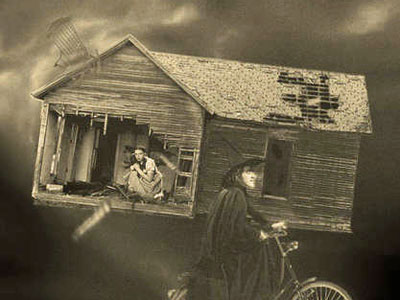
Dorothy, in the eye of the tornado, passes through a liminal portal, or threshold, on her way to Oz. Photo courtesy Warner Bros. Entertainment, Inc.
From the instant a tornado-propelled window frame cracks her on the head, knocking her unconscious, the ritually wounded Dorothy’s inward journey begins, transporting her from the mundane gray world of Kansas depicted by Baum to an enchanted Technicolor realm. In her coma, she enters a dreamlike world, waking up suddenly in a spectacularly colorful fairytale Land of Oz, the other world entered by Dorothy in her deathlike, unconscious state. The poet Robert Bly chants, as he begins his mythopoeic stories: “We are leaving our time now.” In spatial terms, we are also leaving our “world” now. Dorothy Gale (and her audience) are about to enter, as seen in the prelude to the first Star Wars (1977) film, a realm “far, far away.” In this passage out of ordinary space-time into liminal or mythico-ritual space-time, a transition characterized by Eliade (1959) as a movement between “profane” and “sacred” reality (pp. 20-113), Dorothy enters a universal and timeless world, an altered state of consciousness metaphorically represented as the realm of Jung’s primordial images or archetypes, i.e., the collective unconscious. Psychologically, Dorothy’s passage to the other world can be interpreted, in the words of archetypal psychologist James Hillman (1979), as a “transition from the material to the psychical point of view.” Oz, in Hillman’s view, might be interpreted as “the land of soul” (p. 51).
Dorothy leaves Kansas and enters the colorful and bewitching world of Oz, a psychic realm located somewhere in her dreams, an inner landscape that lies “somewhere, over the rainbow.” The tornado sets Dorothy down in Munchkin Land, Campbell’s “zone of magnified power” (1973, p.77). On the other side of the threshold, her destiny becomes the adventure of the archetypal hero-initiate. “Her departure from the familiar farmlands of Kansas into the unknown land of Oz and back again,” writes Morena (1998), echoing Campbell and Houston, “embraces the Call to Adventure, Initiation, and Return that characterize all heroic journeys” (p. 12).
Meeting the Mentor & Securing Supernatural Aid
While the initial stage of Dorothy’s journey clearly corresponds to Campbell’s model, the narrative events occurring immediately after Dorothy enters the other world of Oz reveal significant details confirming Campbell’s interpretation. According to Campbell (1973, pp. 69-89), the hero encounters both superhuman allies and enemies soon after entering the other world. After Dorothy lands in Oz, she quickly learns from the diminutive local citizens, “little people” of classic fairytales that survive in Baum’s story, that she has entered Munchkin Land, somewhere in the Land of Oz. No sooner does she land in this enchanted world than a mysterious figure approaches, flying in a soap-bubble-like orb, a significant added feature in the movie version, such anomalous orb phenomena being closely associated with witches.
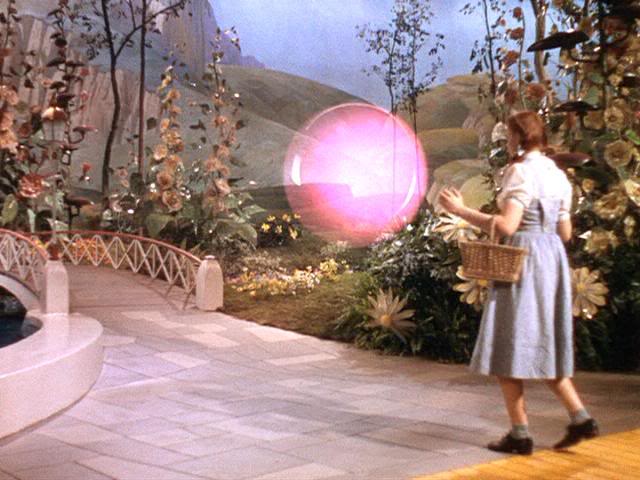
Glinda approaches Dorothy, riding in her magical orb. Photo courtesy of Warner Bros. Entertainment, Inc.
This beautiful “supernatural” being, Glinda (Billy Burke), identifies herself as the Good Witch of the North. Morena (1998) observes: “The required tasks . . . must be completed alone, but accepting the challenge does often elicit the support of supernatural help and protection. When the swirling cyclone deposits Dorothy in Oz . . . a good witch appears to offer assistance” (pp. 11-12).
Along the way, Dorothy acquires a number of magical helpers to aid her quest, but Glinda performs a special role in Dorothy’s adventure from beginning to end. Throughout the narrative, Glinda acts as Dorothy’s archetypal mentor, guide, and protector, a significant symbolic feature lacking in the original story by Baum. As Campbell (1973) observes: “The first encounter of the hero–journey is with a protective figure . . . who provides the adventurer with amulets against the dragon forces he is about to pass” (p. 69). Baum’s original tale holds true to this point. But the good Witch of the North is an old crone; Glinda is the good Witch of the South, who appears much later in the tale. Campbell indicates the helpful crone and fairy godmother figures of European fairy lore as examples of this archetypal figure, qualities artfully combined in Glinda in the film adaptation. This guiding power, he writes, represents the “benign protecting power of destiny” (p. 71), an idea personified in the numinous female figures of Beatrice, in Dante’s descent to the Underworld, and Ariadne, in the Greek myth of Theseus in the labyrinth of the Minotaur (Campbell, 1973, pp. 23-24).
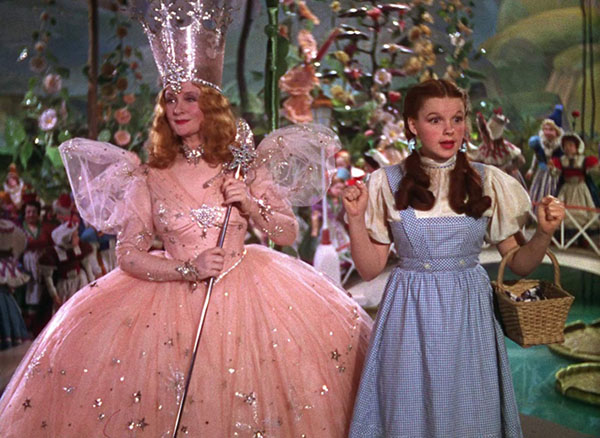
Entering the other world of Oz, Dorothy meets her archetypal ally, guide, and protector, Glinda the Good Witch. Photo courtesy of Warner Bros. Entertainment, Inc.
In Oz, this guiding protective figure is Glinda, the Good Witch, who also embodies the numinous anima archetype in the tale, the anima being, in Jung’s view, a “personification of the collective unconscious” (1990, p. 324). Glinda is a symbol of the divine feminine, her golden hair symbolic of the sun’s luminosity, a sister to Isolde the Fair in the Celtic myth of Tristan and Isolde (Bedier, 1945) and countless archetypal fairytale princesses with golden-hair. In this sense, Glinda personifies both the psyche-soul and divine feminine Self who instructs Dorothy on the use of magical ruby slippers (Campbell’s “amulets”) to protect her against the Wicked Witch (Campbell’s “dragon forces”). Glinda also provides her with a type of Ariadne’s thread—the Yellow Brick Road—to lead her safely through the labyrinthine journey in the wilderness of the Unknown that lies between Munchkin Land, the Emerald City, and Kansas.
In typical hero journey fashion, Glinda’s first question concerns Dorothy’s true identity, a convention metaphorically predicted in Dorothy’s origin myth as an archetypal orphan or divine child, the parent-less hero on a quest of self-discovery, in search of who-they-are. Glinda immediately asks Dorothy: Are you a “good witch” or a “bad witch”? Consistent with her reluctant style of heroism, Dorothy responds that she’s not a witch at all, just an ordinary farm girl, and that Kansas is the star from which she fell, an image of divine descent dating back to creation myths found throughout the world. That she is assumed to be a sorceress, i.e., a being with special powers who fell from a star, is a significant clue to Dorothy’s more-than-human nature. “We’re not in Kansas anymore,” she famously tells Toto. It might be added: Dorothy is not exactly “Dorothy” anymore. In the other world of Oz, she is no longer Dorothy Gale, ordinary farm girl, but the “national hero” of Munchkin Land. Her new heroic status as a powerful, white magic sorceress-redeemer is assumed by Glinda and the Munchkins from the nature of Dorothy’s dramatic and abrupt arrival: her house fell on and crushed the Wicked Witch of the East, a figure Campbell (1973) characterizes as a “threshold guardian” ( p. 77). This event establishes Dorothy’s new role as a “semi-divine” mythic hero and offers important clues to the nature of her forthcoming road of trials as she encounters the threshold guardians who stand “at the entrance to the zone of magnified power” (p.77).
Encountering the Threshold Guardian
Dorothy’s hero journey in the other world, Algeo suggests (1993), is a journey in a Perilous Realm. In the Oz narrative, the peril is personified by the twinned-figures of evil witches: one whom Dorothy has inadvertently slain, and the vengeful survivor who becomes the hero’s nemesis and mortal adversary. No sooner is Dorothy’s heroic identity announced than her initiation begins, as her powerful adversary arrives on the scene, the dark threshold figure of the broomstick riding Wicked Witch of the West (Margaret Hamilton), personifying Jung’s archetypal “shadow” and, in this case, the negative feminine, the counterpart to Glinda’s positive embodiment of anima.
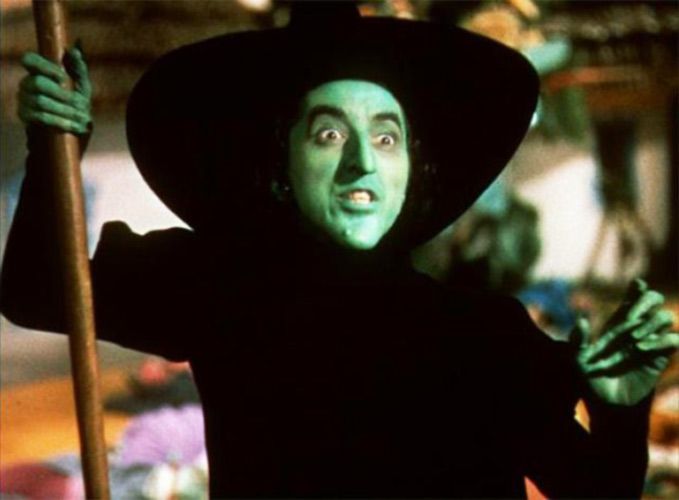
Throughout her journey in Oz, Dorothy is pursued by her supernatural nemesis, the Wicked Witch of the West. Photo courtesy of Warner Bros. Entertainment, Inc.
Her broomstick indicates her occult power over the element of air, the motif of magical flight associated with numerous figures in myth and fairytale and with the paranormal powers attributed to shamans and spiritual adepts the world over. “In the majority of archaic religions,” Eliade (1959) observes, “flight signifies access to a superhuman mode of being (god, magician, spirit)” (p. 176).
Campbell (1973), echoing Jung, also describes this superhuman archetype as a shadow-figure. “The mythological hero, setting forth from his common day hut . . . is . . . carried away . . . to the threshold of adventure. There he encounters a shadow presence that guards the passage” (p. 245). Hillman (1979) amplifies the motif when he writes: “It was at the gates of the underworld that Hercules wrestles with Hades” (pp. 180-183). The Wicked Witch of the West, the shadow presence of this tale, appears (as does her counterpart Glinda) as soon as Dorothy enters the other world, exactly as Campbell describes. This shadow-figure is dressed in funereal black, a color (at least for those of us here in the West) symbolizing forces of darkness that threaten to devour the hero and her entourage, beginning with Toto, who is both Dorothy’s helping animal and her alter-ego in the story. Toto personifies the instinctive feminine, animal-nature that saves Dorothy in times of crisis, an idea developed by Jung’s protégé, the analyst-scholar Marie-Louise von Franz (1980, pp. 59-60), in her discussion of instinct and archetype.
As an embodiment of the devouring mother, the witch is specifically identified by Jung (1959/1971) as a symbol of evil associated with the dragon (pp. 15-16). In his discussion of the monster plot in story narrative Christopher Booker (2004), based on Jung, identifies the witch as a form of monster, an archetypal creature possessing extraordinary powers and traits. According to Booker, the archetypal witch is sinister, fiendish, cunning and “mortally dangerous” (p. 31). Of course, like all true archetypes, the witch is an ambiguous and paradoxical figure. Campbell (1973) says of the threshold guardian: “The herald . . . of the adventure . . . is often dark, loathly, or terrifying, judged evil by the world; yet if one could follow, the way would be opened through the wall of day into the dark where the jewels glow” (p. 53).
With the stage set for unfolding the main plot, Dorothy is instructed by Glinda that in order to reach her goal, to return home to Kansas, she must venture forward on a long and dangerous journey into the Unknown, a journey to the fabled Emerald City—the place where, in Campbell’s words, the “jewels glow.”
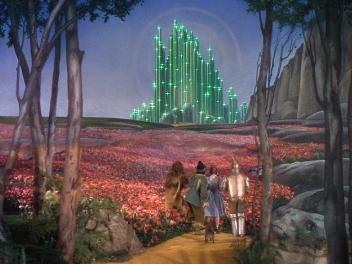
Dorothy and companions emerge from the depths of the forest to glimpse the Emerald City of Oz, the place “where the jewels glow.” Photo courtesy of Warner Bros. Entertainment, Inc.
This important motif of “return,” as both van Gennep (1975, p. 106)and Campbell (1973, pp. 193-244) suggest, is a major structural convention of hero myths and initiatory rites the world around, in this case representing Dorothy’s return from an adventure in the collective unconscious to her ordinary but regenerated life at home. In the Oz narrative, Dorothy cannot complete her return quest without help from the great and powerful, patriarchal god of this realm, the presumably omniscient Wizard of Oz. In this part of the story, the Wizard functions as a masculine complement to Glinda, an ultimately protective figure personifying Jung’s archetypal Wise Old Man (like his counterpart in Dorothy’s ordinary world, Professor Marvel), who supports the hero in the quest for Self, represented in this tale as the quest for “home.” “For Jung,” writes scholar Susan Rowland (2010), “Self becomes a mode of exploring the many ways the psyche has of seeking home” (p. 16).
Dorothy will be protected on her journey in the Perilous Realm by numinous and magical amulets: ruby slippers with which to tread a Yellow Brick Road leading to the Emerald City, the home of the Wizard. Collectively, these shining elemental images evoke both Campbell’s notion of glowing jewels and Jung’s archetypal “treasure hard to attain” (1990, p. 259), of which the Emerald City is itself a perfect symbol and goal.
Once again, a technically minor, but archetypally significant, detail is lost in the screen adaptation of the narrative. With respect to Dorothy’s passage into the other world, the visual metaphor added by the filmmaker makes the symbolism clear, through the vivid visual contrast and abrupt transition from sepia-toned monochromatic imagery to Technicolor. But in the substitution of “ruby” slippers, the archetypal symbolism is obscured, in the same way that the exclusion of the details of Dorothy’s orphaned origins in the screenplay obscures this important archetypal feature of the tale.
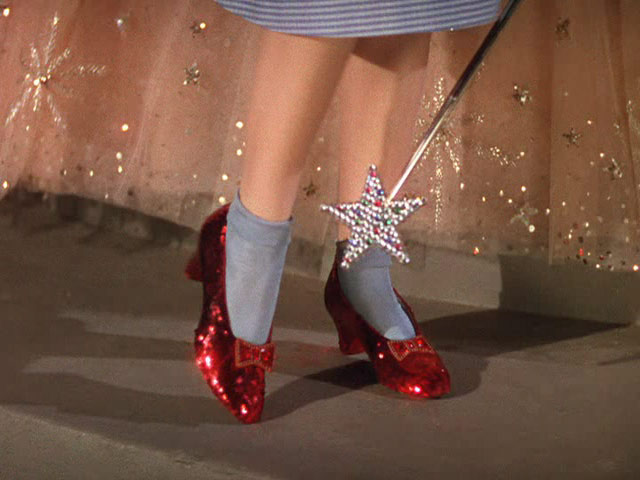
Dorothy’s ruby slippers are her magical amulets for protection against harm. Photo courtesy of Warner Bros. Entertainment, Inc.
In the original version of Baum’s tale, it should be noted, the slippers are not ruby-colored but silver (Baum, 2001, p. 7). While the ruby slippers are visually stunning and preserve the essential meaning of the original symbolism, i.e., power as magical amulets, a symbolic feature associated with the ancient Goddess religions is diminished in the adaptation.
In Pagan symbolism, the Goddess is associated with the power of the Moon, silver being symbolically lunar; her masculine counterpart, the god, is associated with the sun and color symbolism of gold, an idea explored by von Franz (1980,p. 44). And just as the daily cycle of the golden sun is associated by Jung with the sun-hero’s descent and return, the monthly cycle of the silvered-Moon has been associated, since ancient times, with the death-rebirth symbolism of the feminine lunar cycle enacted in the mystery rites of the Goddess. When the Wicked Witch of the West arrives, she attempts to retrieve the slippers from her dead sister, slippers that function as amulets preserving the magical lunar power of the Goddess, the power of death and rebirth associated with the Moon-cycle that properly belongs to Dorothy in her role as initiate-hero. But the slippers magically appear on Dorothy’s feet before the witch can obtain them. Angered, the Wicked Witch, personifying the negative feminine and the unconscious, sets her dark will against the young hero. Glinda warns Dorothy that she must never take off the slippers—her magical power of death-rebirth—if she would achieve her goal. But the Wicked Witch is intent on obtaining the slippers from Dorothy’s feet by whatever means necessary. Hence, the dynamic life and death struggle between the hero, Dorothy, and the Wicked Witch of the West, the devouring or negative Mother, is established as the central dramatic plot of the tale.
Conclusions and Recommendations for Further Study
In its initial stage, Dorothy’s adventure in Oz conforms in significant detail to the symbolic, archetypal structures and motifs attributed to classic hero myths by Joseph Campbell. Clearly, Dorothy Gale is a hero who, in Campbell’s (1973) terms, “ventures forth from the world of common day into a region of supernatural wonder” (p. 30) a passage further defined by an array of sequentially interconnected, recurring myth-motifs. Dorothy’s fantastic journey starts by introducing a series of archetypal figures and events bearing close analogies to Campbell’s composite model of the leitmotif of the monomyth. From Dorothy’s common day life in Kansas and her involuntary call to adventure and tornado-driven threshold passage into the other world to the dangerous threshold guardians that oppose her and the supernatural mentor and ally who guides and protects her, the initial stage of the Oz adventure resembles in both broad structural outline and symbolic detail, the path of countless archetypal heroes, past, present, and (predictably) future.
From her orphan-hero origins to the more-than-human figures that oppose and protect her, Dorothy reincarnates a heroic lineage that stretches from the world’s creation myths down through the ages to the contemporary movie box office, where its latest incarnations—from Spiderman to Harry Potter—still reign supreme. Protected by the magical potency of an amulet (ruby slippers), Dorothy’s archetypal, initiatory descent will soon continue as she embarks on the “pathless path” of the hero, a favorite myth-motif of Campbell, in this case a narrow road paved with gold that, in the depths of Dorothy’s quest, completely disappears. To complete her journey safely, Glinda warns the young hero, she must wear the ruby slippers and follow the path of the Yellow Brick Road, leading straight to Oz and the Wizard’s assistance in her return. As Devlin (1996) suggests, this path of the Yellow Brick Road is the “soul’s way home.”
While the Yellow Brick Road is part of the original story by Baum, the filmmaker adds yet another important visual feature in the film version: the source-point of the road unfolds directly beneath Dorothy’s feet. This image in the movie version of a numinous, golden path spiraling out from the center of Munchkin Land, unfurling from its center directly below Dorothy’s feet, suggests analogous motifs in the hero myths of classical Greece and Rome. The golden spiral followed by Dorothy, for instance, evokes the aura of Ariadne’s thread, the magical ball of wound linen yarn followed by Theseus as he returns from the labyrinth after slaying the Minotaur. This symbolic anchor point upon which Dorothy stands and from which her journey begins, pictured in the movie as an unfolding spiral labyrinth, functions in Baum’s narrative as an axis mundi or symbolic center of Dorothy’s new world (Eliade, 1959, pp. 36-42).
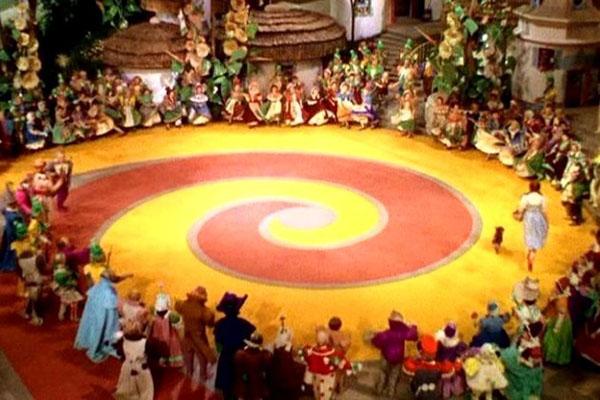
The axis mundi of Dorothy’s new world in Oz, imagined as an unfolding spiral Yellow Brick Road. Photo courtesy of Warner Bros. Entertainment, Inc.
With the numinous image of the mythical golden thread beneath her feet, similarly evoking the “golden bough” of Aeneas illuminating the underworld path that lies ahead, Dorothy descends into the magical and Perilous Land, as her transformational, initiatory journey along a mythical road of trials begins—a magical journey through the inner realm of archetypes that lies between her old self and the new.
Recommendations for Further Study
I view my academic work as that of developing a scholarly research-writing-teaching platform addressing the broad subject area of “mythic structure in storytelling,” an umbrella theme representing the general focus of my research that holds interpretive implications for diverse disciplines in the social sciences, arts, and humanities, including literary/film criticism, myth and ritual studies, comparative religion, cultural history, creative writing, and depth psychology. Given the importance of this study as my first published academic paper on this subject, I approach these recommendations for further study within that broad interdisciplinary research framework. Several scenarios for additional study are indicated.
An obvious starting point would be further comparison of Campbell’s monomyth with Dorothy’s journey. A close reading of Dorothy’s continuing adventures in Oz, her road of trials and journey of descent and equally difficult journey of return will, according to my preliminary research, reveal significant additional symbolic analogies between the universal imagery of Campbell’s hero quest and Baum’s narrative. While recent researchers, including Hudlin (1989), Morena (1998), and Houston (2012), have recognized the importance of The Wizard of Oz as at least generally illustrative of Campbell’s hero quest, further amplification and interpretation of the Oz narrative in comparison with Campbell’s monomyth may reveal new symbolic meanings when viewed from the unique viewpoint offered by every new interpreter.
A simpler research scenario might consist of a more thorough analysis of archetypal motifs shared by Dorothy and shamans the world over. It should be clear from the brief references incorporated in this study that Dorothy’s adventures can be interpreted as a kind of shamanic initiation. Like shamans and initiates of many cultures, Dorothy’s initiation begins with a form of initiatory sickness or wound, in her case a serious head injury resulting in coma. Analogous to shamans, she uses talismans and sacred amulets (silver or ruby slippers) and acquires helping animal allies (e.g., Toto and Cowardly Lion). Also, similar to shamans, she undergoes a journey of dangerous descent (through descending levels of forest) into an underworld where a transformational healing occurs in which Dorothy defeats death incarnate (the Witch). This is followed by a journey of ascent or magic flight to Kansas, where she wakes from her death-like coma, her life restored. Her continued journeys in Baum’s many sequels clearly indicate that Dorothy becomes, in Campbell’s words, a “master of two worlds” (1973, pp. 229-237).
Another scenario might consist of tracing the history of a single archetypal image, for instance, that of the mythic orphan that Dorothy Gale represents. To date, I’ve compiled more than 400 examples of the primordial image of the orphan in fairytales, myths, literature, and cinematic narratives. The figure can be traced back in time, from contemporary orphan-heroes like Harry Potter, Batman, and the orphaned Stark children of Game of Thrones, to their semi-divine prototypes, for example, the orphan-heroes of Celtic, Mayan, and Chinese creation myths. Such research might support an argument for a major correction in Campbell’s hero myth model, adding the archetypal orphan-foundling-hero as an overarching structural clue to the nature of hero myths (i.e., identity quests) as suggested in the present paper.
A more complex research scenario might take as its point of departure the obvious analogies between Campbell’s exegesis of the hero quest myth and the complementary theories and interpretive approaches of Jung (depth psychology), van Gennep (anthropology), and Eliade (history of religions) as suggested in the theoretical Introduction to this study. Taken together, these pioneering, “archetypal” scholars appear to offer highly compatible interpretations suggesting that the basic universal structure of mythic and ritual narrative is that of a transformational journey of soul whose essential meaning is that of death-rebirth, pictured universally and from the dawn of time to the present day in the topographical symbolism of descent and return—the three-stage structure of shamanic initiations, myths of hero quests, and initiatory rites of all kinds. In short, these scholars, representing various disciplines in the humanities and social sciences, all interpret the initiate-hero’s story, within the limits imposed by their disciplines, as a journey of psychic transformation represented by the symbolism of death and rebirth, expressed in the imagery of descent and return.
In short, an interdisciplinary interpretive consensus on fundamental, acknowledged meanings of structure and symbolism in shamanic initiatory phenomena, myth, and ritual—and by extension, derivative modern storytelling forms of literature and film—appears to be well-established. A more thorough, detailed comparison of the respective theories and interpretations of these scholars, as well as other key sources, might illustrate my hypothesis that, collectively, these compatible interpretive frameworks form a type of theoretical Rosetta Stone for the symbolic interpretation of mythopoeic-archetypal imagery and narrative in whatever forms they may appear. Such an integrated, multi-disciplinary interpretive approach might be meaningfully applied not only to Dorothy’s tale but to all mythopoeic quest narratives, regardless of their genres and oral, literary, or cinematic storytelling forms.
Finally, interpretations of mythopoeic-archetypal narratives by various Jungian analyst-scholars may be applied to the Oz narrative with resulting new psychological insights. A detailed comparison of Dorothy’s adventure to the psychological analyses of fairytales found in the prolific interpretive works on that subject by Marie-Louise von Franz (1996) is but one research scenario, worthy in itself of a thesis or dissertation-length study. The same can be said of comparing Dorothy’s adventure to the Celtic myths and hero tales interpreted by John Layard (1975), or the analysis of Shakespeare’s plays by Edward Edinger (2001). Such insightful analytical studies reveal the meaningful relationship between the unconscious psyche and the symbolic narratives in which psyche creatively expresses and describes itself. Each of these authors—and similar analyses by a growing number of Jungian analyst-scholars—might yield considerable insight, for example, into Dorothy’s adventures and their prospective analogies to Jung’s individuation process. The interpretation of archetypal tales like Baum’s by Jungian scholars—whose theories and methods of interpretation are grounded in the pragmatic, therapeutically-oriented depth psychology of Jung—help reveal the psychological depth and relevance of Dorothy’s tale, and similar stories down through the ages, as symbolic guideposts and maps for personal growth and self-discovery. Such narratives, as well as their equivalents in other art forms, like painting, theater, and dance, serve as loci of psychological meaning.
Jung and Campbell respectively forged interpretive approaches that affirm the human soul and its symbolic language of recurrent themes and images—images that, undimmed by time and unlimited by space, speak eloquently in the dreams, fantasies, religions, and art of the world’s cultures, from primeval past to the post-modern present. Viewed from a perspective grounded in the “myth-criticism” of Jung and Campbell, the primordial images of which such narratives are constructed may function as metaphorical mirrors for self-reflection and self-understanding. In the symbolic structures and motifs of the hero quest as they appear in the mirror of narrative arts, contemporary individuals may glimpse, “as through a glass, darkly” (I Corinthians, 13:12). the mysterious structures and transformative processes of the unconscious psyche.
In this way, the aesthetic and entertainment values typically assigned to the forms of narrative art—when viewed through the lens of depth psychological theory and archetypal criticism—may be transformed into powerful tools for self-discovery. Houston (2012) proves this magnificently in her bestselling book on Oz, inviting each reader to live their own mythic life by following the metaphorical Yellow Brick Road. Such perspectives fulfill the promise of the combined interpretive thrusts offered by Jung and Campbell, reaching back to Plato’s dialogue—summarized by Ernst Cassirer (1953, pp. 1-2)—between Phaedrus and his mentor Socrates, who saw in the images and figures of Greek mythology, a practical method for implementing the wisdom-practice expressed in the motto at Delphi: “Know thyself.”
This insight into the integral relationship between processes of psychological transformation and development, psyche’s primitive capacity for symbolic thought, and the narrative forms in which psyche finds both aesthetic and teleological expression, can be summarized in Jung’s observation that psyche and world reflect each other. That which is inside, is outside, too. Thus understood, the mythico-ritual narratives of the world told by master storytellers down through the ages collectively form a global mosaic of archetypal narrative from which any individual and local variation—The Wizard of Oz is but one example—may function as a metaphorical mirror for self-knowledge when viewed from the perspective of depth psychology. In this universal mirror of art, constructed in an ancient grammar of symbols and primordial images (as well as in its individual, indigenous variations), those with eyes to see may, in the words of Shakespeare’s Hamlet, “see the inmost part of you” (Hamlet, 3.4.18-19). As Campbell (1973) observes, “The latest incarnation of Oedipus . . . stand[s] this afternoon on the corner of Forty-second Street and Fifth Avenue waiting for the traffic light to change” (p. 4). Bruno Bettelheim (1989) quotes the philosopher Aristotle, who in a similar spirit declared, more than two millennia ago: “A friend of wisdom is also a friend of myth” (p. 35).
References
Algeo, J. (1993, Summer). The Wizard of Oz: The perilous journey [Electronic version]. Quest, 6(2), 48-55.Retrieved from http://www.theosophical.org/publications/quest-magazine/1581
Alighieri, D. (1982). The inferno (J. Ciardi, Trans.). New York, NY: New American Library. Bachofen, J. J. (1992). Myth, religion, and mother right: Selected writings of J. J. Bachofen (R.
Mannheim, Trans.). J. Campbell, Ed. Princeton, NJ: Princeton University Press.
Baum, L. F. (1900). The wonderful wizard of Oz (1st ed.). Chicago, IL: George M. Hill.
Baum, L. F. (2001). The wonderful wizard of Oz. New York, NY: Scholastic.
Bedier, J. (1945). The romance of Tristan and Iseult (H. Belloc, Trans.). New York, NY: Pantheon Books.
Bettelheim, B. (1989). The uses of enchantment: The meaning and importance of fairytales. New York, NY: Vintage Books.
Booker, C. (2004). The seven basic plots: Why we tell stories (2nd ed.). New York, NY:Continuum International.
Boyer, R. L. (2011). Key archetypes in Tristan and Isolde: A brief introduction.
https://www.academia.edu/622341/Key_Archetypes_in_the_Celtic_Myth_of_Tristan_and_Isolde_A_Brief_Introduction. Manuscript submitted for publication.
Boyer, R. L. (2012, August). Introduction to the mythic orphan: Archetypal origins of the hero in mythology, literature, and film. Paper presented at Symposium for the Study of Myth, Santa Barbara, CA.
Briffault, R. (1927). The mothers: A study of the origins of sentiments and institutions (Vol. 2).New York, NY: Macmillan.
Campbell, J. (1973). The hero with a thousand faces (3rd ed.). Princeton, NJ: Princeton University Press.
Campbell, J. (1991). The power of myth: with Bill Moyers (2nd ed.). B. S. Flowers (Ed.). New York, NY: Anchor Books.
Carroll, R. & Radford, B. (Producers); Finn, W. & St. Pierre, D. (Directors). (2013).
Legends of Oz: Dorothy’s return [Motion picture]. United States: Summertime Entertainment.
Cassirer, E. (1953). Language and myth. S. Langer (Trans.). New York, NY: Dover.
Devlin, M. (1996, Fall). The great cosmic fairy tale [Electronic version]. Gnosis Magazine, 41(30), 35. Retrieved from http://www.gnosismagazine.com/issue_contents/contents41.html
Edinger, E.F. (2001). The psyche on stage: Individuation motifs in Shakespeare and Sophocles.
Toronto, Canada: Inner City Books.
Eliade, M. (1951). Shamanism: Archaic techniques of ecstasy (W. R. Trask, Trans.).
Bollingen Series LXXVI. Princeton, NJ: Princeton University Press.
Eliade, M. (1958). Rites and symbols of initiation: The mysteries of birth and rebirth (W. R. Trask, Trans.). New York, NY: Harper Torchbooks.
Eliade, M. (1959). The sacred and the profane: The nature of religion (W. R. Trask, Trans.).
Princeton, NJ: Princeton University Press.
Frye, N. (1963). Fables of identity: Studies in poetic mythology. New York, NY: Harcourt, Brace & World.
Harper, K. (Producer). (1975). The wiz: The super-soul musical “wonderful wizard of Oz” [Theatrical stage play]. United States.
Hillman, J. (1979). The dream and the underworld (1st ed.). New York. NY: Harper & Row.
Houston, J. (2012). The wizard of us: Transformational lessons from Oz. New York, NY: Atria
Hudlin, E. W. (1989, Fall). The mythology of Oz: An interpretation [Electronic version]. Papers on Language and Literature, 25(4), 443–462. Retrieved from http://www.entoes.com/twentieth-century-criticism/baum-frank/edward-w-hudlin-essay-date-fall-1989
Jung, C. G. (1958).Psychology and religion(R.F.C. Hull, Trans.).In H. Read et al (Series Eds.), The collected works of C. G. Jung (vol. 11, para. 88; 1st ed.).Princeton, NJ: Princeton University Press.(Original work published 1937)
Jung, C. G. (1971). Four archetypes: Mother/rebirth/spirit/trickster (R. F. C. Hull, Trans.).
Extracted from The archetypes of the collective unconscious in H. Read et al (Series Eds.), The collected works of C. G. Jung (vol. 9, pt.1; Rev. ed.). Princeton, NJ: Princeton University Press. (Original work published 1959)
Jung, C. G. (1974). The structure of the psyche (R. F. C. Hull, Trans.). In J. Campbell (Ed.),
The portable Jung. New York, NY: Viking. Extracted from H. Read et al (Series
Eds.), The collected works of C. G. Jung (vol. 8, para. 283-342). (Original work published 1927)
Jung, C. G. (1980).The archetypes and the collective unconscious (R. F. C. Hull, Trans.). In H.
Read et al (Series Eds.), The collected works of C. G. Jung (vol. 9 pt. 1; 2nd ed.).Princeton, NJ: Princeton University Press. (Original work published 1959)
Jung, C. G. (1989). Memories, dreams, reflections (R. & C. Winston). (Rev. ed.). A. Jaffe, Ed.
New York, NY: Vintage Books. (Original work published 1961)
Jung, C. G. (1990). Symbols of Transformation: An analysis of the prelude to a case of schizophrenia (R. F. C. Hull, Trans.). In H. Read et al (Series Eds.), The collective works of C. G. Jung (vol. 5, 2nd ed.). Princeton, NJ: Princeton University Press. (Original work published as Psychology of the Unconscious, 1916)
Jung, C. G. (1992). The psychology of the transference (R. F. C. Hull, Trans.). Extracted from The Practice of Psychotherapy in H. Read et al (Series Eds.), The collective works of C. G. Jung (vol. 16, 2nd ed., para. 455) Princeton, NJ: Princeton University Press. (Original work published 1954)
Jung, C. G. (2001). Psychology of the unconscious: A study of the transformations and symbolisms of the libido (B. M. Hinkle, Trans.). (Rev. ed.). Princeton, NJ: Princeton University Press. (Original work published in 1916)
Kerenyi, C. & Jung, C. G. (1973). Essays on a science of mythology: The myth of the divine child and the mysteries of Eleusis. Princeton, NJ: Princeton University Press.
Kurtz, G. (Producer), & Lucas, G. (Director). (1977). Star wars [Motion picture]. United States: Lucasfilm & 20th Century Fox.
Layard, J. (1975). A Celtic quest: Sexuality and soul in individuation: A depth-psychology study of the Mabinogian legend of Culhwch and Olwen (Rev. ed.). Zurich, Switzerland:
Leroy, M. (Producer), and Fleming, V. (Director). (1939). The Wizard of Oz [Motion picture]. United States: MGM.
Mann, M. P. (2003). Doorways to other worlds: The infinite fractal energies of Faery. Parabola: Myth, Tradition and the Search for Meaning, 28(3), 6–11.
Morena, G. D. (1998). The wisdom of Oz: Reflections of a Jungian sandplay therapist (1st ed.). San Diego, CA: InnerConnections Press.
Mythopoeic literature. (n.d.). In Mythopoeic Society, “About the Society.” Retrieved from http://www.mythsoc.org/about/
Neumann, E. (1974). Art and the creative unconscious (R. Mannheim, Trans.). Princeton, NJ: Princeton University Press.
Pearson, C. S. (1998). The hero within: Six archetypes we live by (3rd ed). New York, NY: Harper & Row.
Platt, M. and Stone, D. (Producers), & Montello, J. (Director). (2003). Wicked: The untold story of the witches of Oz [Theatrical stage play]. United States: Universal Studios.
Rank, O. (1964). The myth of the birth of the hero and other writings (P. Freund, Trans.). New York, NY: Alfred Knopf.
Rock, A. J. & Krippner, S. (2011). Demystifying shamans and their world: An interdisciplinary study. Charlottesville, VA: Imprint Academic Philosophy Documentation Center.
Rodriguez, C. S. (2003, April). Pathways to the Self: Threshold places. MetaArts: The magazine of the metaphysical, spiritual & healing communities. Retrieved from http://www.themetaarts.com/archives/200304/connier.html
Roth, J. (Producer) & Raimi, S. (Director). (2013). Oz the great and powerful [Motion picture]. United States: Walt Disney Pictures.
Rowland, S. (2010). C. G. Jung in the humanities: Taking the soul’s path. New Orleans, LA: Spring.
Tolkien, J. R. R. (2001). Mythopoeia. In J. R. R. Tolkien, Tree and leaf: Including mythopoeia and the homecoming of Beorhtnoth (Rev. ed.), pp. 83-91. New York, NY: HarperCollins.
Tolkien, J. R. R. (2001). On fairy-stories. In J. R. R. Tolkien, Tree and leaf: Including mythopoeia and the homecoming of Beorhtnoth (Rev. ed.), pp. 1-82. New York, NY: HarperCollins.
Turner, V. (1991).The ritual process: Structure and anti-structure.Ithaca, NY: Cornell University Press.
van Gennep, A. (1975). The rites of passage. Chicago, IL: University of Chicago Press.
von Franz, M.-L. (1980). Alchemy: An introduction to the symbolism and psychology: Studies in Jungian psychology (1st ed). Toronto, Ontario, Canada: Inner City Books.
von Franz, M.-L. (1996). The interpretation of fairytales (Rev. ed.). Boston, MA: Shambhala.
von Goethe, J. (1814) The holy longing (R. Bly, Trans.). In R. Bly (Ed.), News of the universe: Poems of twofold consciousness (1980).San Francisco, CA: Sierra Club Books.
Ronald L. Boyer is a scholar, teacher, and award-winning poet, fiction author and screenwriter. He is currently completing his M. A. in Depth Psychology at Sonoma State University, where he taught his first university course, “Mythic Structure in Storytelling™,” a creative writing course grounded in the archetypal theories of Carl G. Jung and Joseph Campbell (syllabus available at www.sonoma.academia.edu/RonaldLBoyer). While completing his graduate studies, Boyer presented an academic paper, “Introduction to the Mythic Orphan: Archetypal Origins of the Hero in Mythology, Literature and Film,” at the Symposium for the Study of Myth, co-sponsored by Pacifica Graduate Institution, OPUS Archives, and the Joseph Campbell Foundation. He will present a paper at the forthcoming international conference of the International Association of Jungian Studies on the topic of “To Die, and Be Reborn: The Death-Rebirth Archetype in Myth & Rite, Literature & Film.”
Boyer is a graduate of the Professional Program in Screenwriting at UCLA School of Theater, Film and Television. He is a two-time Jefferson Scholar to the Santa Barbara Writers Conference, and two-time award-winner for fiction from the John E. Profant Foundation for the Arts, including the McGwire Family Award for Literature. Boyer’s poetry has been featured in the peer-reviewed scholarly e-zine of the Jungian and depth psychology community, Depth Insights: Seeing the World with Soul (Issues 3 and 5, Fall 2012 and 2013) and in Mythic Passages: A Magazine of the Imagination (January 2008). Three poems and his first contemporary fairytale have been accepted for publication in Mythic Circle, the literary magazine of the Mythopoeic Society. He will begin doctoral studies this Fall in the PhD in Art and Religion program at the Graduate Theological Union in Berkeley, CA.
